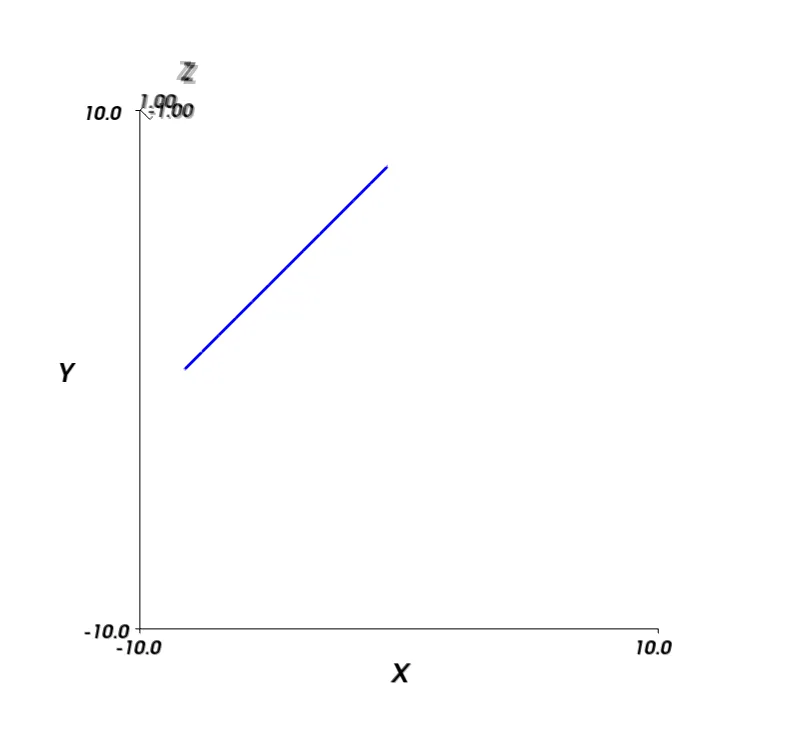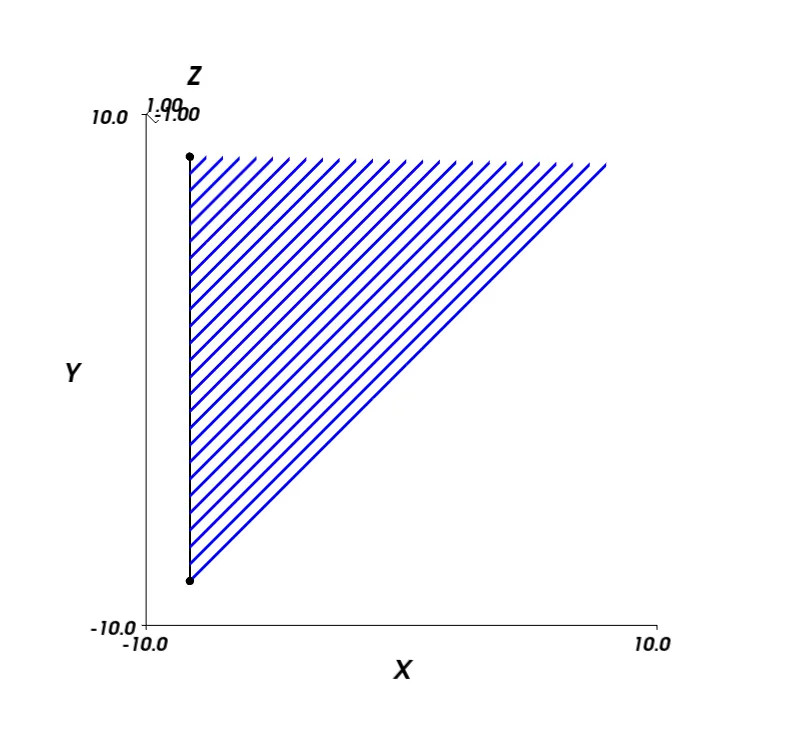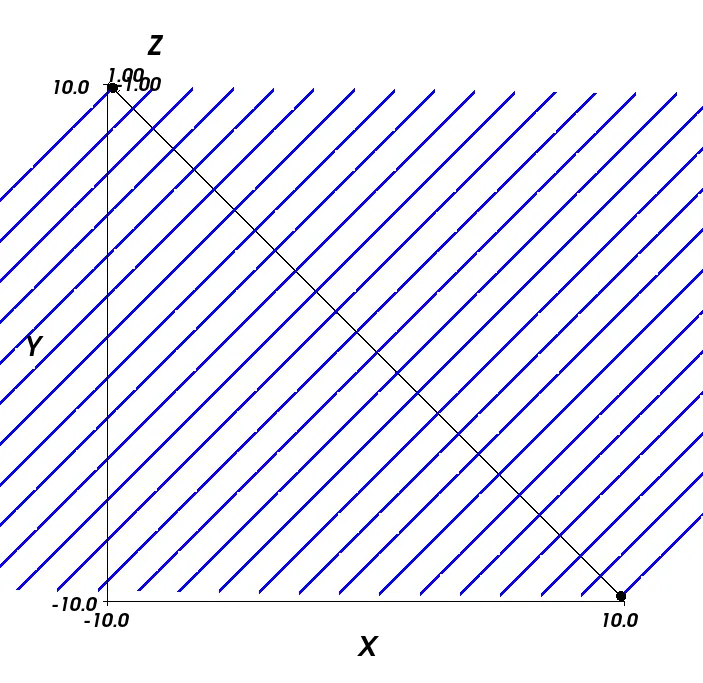最近,Tom Flannaghan和Tony Yu将streamplot纳入matplotlib中,因此使用python和matplotlib生成2D流图非常容易。
尽管可以使用matplotlib生成某些类型的3D图,但目前不支持3D流图。然而,Python绘图程序mayavi(提供基于vtk的绘图的Python接口)可以使用其flow()函数生成3D流图。
我创建了一个简单的Python模块来在2D和3D中流绘制数据,其中3D数据集中没有Z坡度(所有dZ = 0),以展示我在mayavi与matplotlib上面对匹配xy平面数据绘图挑战的情况。以下是有注释的代码和生成的图形:
import numpy, matplotlib, mayavi, matplotlib.pyplot, mayavi.mlab
#for now, let's produce artificial streamline data sets for 2D & 3D cases where x and y change by +1 at each point, while Z changes by 0 at each point:
#2D data first:
x = numpy.ones((10,10))
y = numpy.ones((10,10))
#and a corresponding meshgrid:
Y,X = numpy.mgrid[-10:10:10j,-10:10:10j]
#now 3D data with Z = 0 (i.e., I want to be able to produce a matching streamplot plane in mayavi, which is normally used for 3D):
xx = numpy.ones((10,10,10))
yy = numpy.ones((10,10,10))
zz = numpy.zeros((10,10,10))
#and a corresponding meshgrid:
ZZ,YY,XX = numpy.mgrid[-10:10:10j,-10:10:10j,-10:10:10j]
#plot the 2D streamplot data with matplotlib:
fig = matplotlib.pyplot.figure()
ax = fig.add_subplot(111,aspect='equal')
speed = numpy.sqrt(x*x + y*y)
ax.streamplot(X, Y, x, y, color=x, linewidth=2, cmap=matplotlib.pyplot.cm.autumn,arrowsize=3)
fig.savefig('test_streamplot_2D.png',dpi=300)
#there's no streamplot 3D available in matplotlib, so try to see how mayavi behaves with a similar 3D data set:
fig = mayavi.mlab.figure(bgcolor=(1.0,1.0,1.0),size=(800,800),fgcolor=(0, 0, 0))
st = mayavi.mlab.flow(XX,YY,ZZ,xx,yy,zz,line_width=4,seedtype='sphere',integration_direction='forward') #sphere is the default seed type
mayavi.mlab.axes(extent = [-10.0,10.0,-10.0,10.0,-1.0,1.0]) #set plot bounds
fig.scene.z_plus_view() #adjust the view for a perspective along z (xy plane flat)
mayavi.mlab.savefig('test_streamplot_3D_attempt_1.png')
#now start to modify the mayavi code to see if I can 'seed in' more streamlines (default only produces a single short streamline, albeit of the correct slope)
#attempt 2 uses a line seed / widget over the specified bounds (points 1 and 2):
fig = mayavi.mlab.figure(bgcolor=(1.0,1.0,1.0),size=(800,800),fgcolor=(0, 0, 0))
st = mayavi.mlab.flow(XX,YY,ZZ,xx,yy,zz,line_width=4,seedtype='line',integration_direction='forward') #line instead of sphere
st.seed.widget.point1 = [0,-10,0]
st.seed.widget.point2 = [0,10,0] #so seed line should go up along y axis
st.seed.widget.resolution = 25 #seems to be the number of seeds points along the seed line
mayavi.mlab.axes(extent = [-10.0,10.0,-10.0,10.0,-1.0,1.0]) #set plot bounds
fig.scene.z_plus_view() #adjust the view for a perspective along z (xy plane flat)
mayavi.mlab.savefig('test_streamplot_3D_attempt_2.png')
#attempt 3 will try to seed a diagonal line across the plot to produce streamlines that cover the full plot:
#would need to use 'both' for integration_direction if I could get the diagonal seed line to work
fig = mayavi.mlab.figure(bgcolor=(1.0,1.0,1.0),size=(800,800),fgcolor=(0, 0, 0))
st = mayavi.mlab.flow(XX,YY,ZZ,xx,yy,zz,line_width=4,seedtype='line',integration_direction='forward')
st.seed.widget.point1 = [-10,10,0] #start seed line at top left corner of plot
st.seed.widget.point2 = [10,-10,0] #end seed line at bottom right corner of plot
#this fails to produce a diagonal seed line though
st.seed.widget.resolution = 25 #seems to be the number of seeds points along the seed line
mayavi.mlab.axes(extent = [-10.0,10.0,-10.0,10.0,-1.0,1.0]) #set plot bounds
fig.scene.z_plus_view() #adjust the view for a perspective along z (xy plane flat)
mayavi.mlab.savefig('test_streamplot_3D_attempt_3.png')
2D matplotlib结果(请注意,斜率为1的流线与填充有单位值的dx和dy数组相匹配):
 3D mayavi结果(尝试1; 请注意,单个流线的斜率是正确的,但流线的长度和数量显然与2D matplotlib示例不同):
3D mayavi结果(尝试1; 请注意,单个流线的斜率是正确的,但流线的长度和数量显然与2D matplotlib示例不同):
 3D mayavi结果(尝试2; 请注意,我使用具有足够高分辨率的线种子产生了更多适当斜率的流线,但是请注意,在代码中指定的黑色种子线的起始和结束x坐标与绘图不匹配)
3D mayavi结果(尝试2; 请注意,我使用具有足够高分辨率的线种子产生了更多适当斜率的流线,但是请注意,在代码中指定的黑色种子线的起始和结束x坐标与绘图不匹配)
 最后,尝试#3(令人困惑地)产生与#2完全相同的情节,尽管指定了不同的种子/小部件点。因此,问题是:如何更好地控制我的种子线的位置使其成为对角线?更广泛地说,我想能够输入任意阵列的种子点以解决更一般的流图3D(非平面)问题,但是解决前者特定情况的线条应该让我开始。
最后,尝试#3(令人困惑地)产生与#2完全相同的情节,尽管指定了不同的种子/小部件点。因此,问题是:如何更好地控制我的种子线的位置使其成为对角线?更广泛地说,我想能够输入任意阵列的种子点以解决更一般的流图3D(非平面)问题,但是解决前者特定情况的线条应该让我开始。
在解决这个问题时,我找到了一些其他有用的资源,但它们并没有完全解决我的问题:
- matplotlib的streamplot共同作者Tom Flannaghan在博客文章中讨论了这个主题
- 一个示例,其中使用自定义种子数组与mayavi Streamline子类(其又被flow()使用),但遗憾的是缺乏足够的实现细节无法复现。
- 使用mayavi生成二维磁力线流图的示例,包括注释源代码。
- 带有三维源代码的类似示例,但仍然无法解决我的绘图问题:
- mayavi标准文档提供的flow() 绘图结果示例代码(流线后面可见球形种子小部件)。
 您可能之前就熟悉了从Mayavi中探索的方法,但为了避免解释过多,我还是会提到:我通常通过启用pylab来运行IPython脚本来找到Mayavi中这种模糊属性的选项。在Ubuntu上,终端命令如下:
您可能之前就熟悉了从Mayavi中探索的方法,但为了避免解释过多,我还是会提到:我通常通过启用pylab来运行IPython脚本来找到Mayavi中这种模糊属性的选项。在Ubuntu上,终端命令如下: 打开一个窗口,显示您更改设置的代码等效项:
打开一个窗口,显示您更改设置的代码等效项: